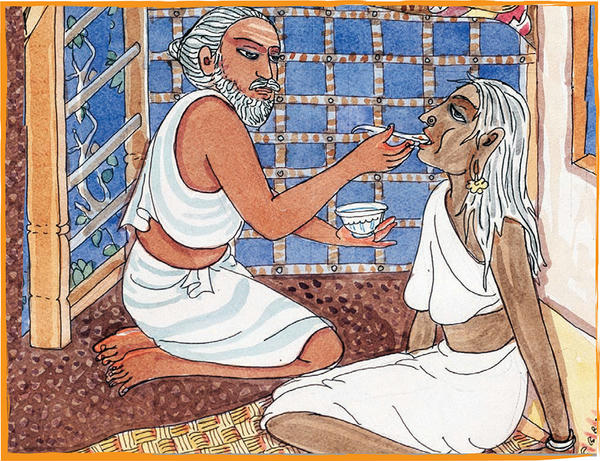38 Who Are Our Holy Men & Women?§
Chellachiamma was a saintly Sri Lankan woman, so loved and respected by Sage Yogaswami that he would walk miles to cook for and feed her, just as she had given spiritual sustenance to all who came to her ashram.§
S. RAJAM§
Saivism has many holy men and women. All are great devotees of Siva, Murugan and Ganesha. We honor living holy ones on their birthday, or jayanti. Those who have left this Earth we revere on the day of their passing, or mahasamadhi—their new birthday. Saints reflect the peace, humility and purity of a devout life. Sages are great souls who may outwardly appear ordinary. Satgurus are enlightened beings who guide others on the path. Holy men and women—married people as well as gurus, sadhus and swamis—have stood strong for Saivism at critical times throughout history. Many traveled widely and spread Saivite culture and knowledge to new areas. Some were solitary mystics, meditating and performing yoga. Some wrote scriptures or composed beautiful songs to God that we sing today. Our lineage began over 2,000 years ago with Maharishi Nandinatha, a yoga master from Kashmir. His disciple Sundaranatha, later known as Rishi Tirumular, traveled by foot to South India to teach Saivism. Our many gurus followed from him. Other Saivite traditions include that of Matsyendranatha and his disciple Gorakshanatha, who expounded hatha yoga and spread Natha Saivism through central India and Nepal. The many women saints include the austere yogini Karaikkal Ammaiyar and the beloved Saint Auvaiyar, whose poems children study to learn religion and good conduct. Among the most famous Tamil Saiva saints are the Nalvars, who kept Saivism strong in Tamil Nadu twelve centuries ago.§
GURUDEVA: Though it may not be your dharma to formally renounce the world, you can benefit your search immensely by knowing how the great ones seek to live and respond to life. You can find ways in the midst of your life to follow their example.§

